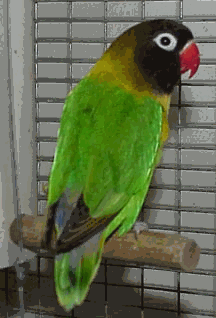
The Masked Lovebird (Agapornis personata) is one of nine species of Lovebirds. It's one of the four eye-ring species. Its closest cousin is the Fischer's (Agapornis fischeri). The other two of this group are the Black-Cheeked (Agapornis nigrigenis) and the Nyasa (Agapornis lilianae). These four separate species are so closely related that hybrids are fertile. For this reason they should never be crossbred. This ruins the gene pool of all the species involved. The birds used to be called Black Masked, now they are called by their body color: Green Masked, Blue Masked, Yellow Masked, etc.
Found in northeastern Tanzania, Africa, from Lake Manyara south to the Iringa Highlands. They inhibit inland plateaus bordered in the east by the Pangani Valley and in the In the wild, Masked lovebirds are south by forested mountains. Its habitat is wooded grasslands dominated by acacias. They were discovered in the late 1800's.
***DESCRIPTION***
The Masked lovebird is a chunky little bird 5-6" in length. It has a black head and face, red beak, green body, yellow chest and band around to the back, black flights with green on the front edge, a touch of blue in the rump that
looks like it was dry brushed on, green with black and a touch of orange tail feathers. The females are generally larger than the males. Average weights for a Masked range from 40-55 grams. Some hens have been known to weigh as much as 60 grams.
***NESTING & BREEDING***
Masked Lovebirds breed well in both a colony or cage situation. In a colony, always make sure you have at least 1 1/2 times as many nestboxes as you have pairs, double the amount of nestboxes is even better. A typical cage for a single pair would be 24" x 24" x 18". The smallest I would put them in is 36" x 18" x 18". Typical nestboxes should measure 8" x 8" x 9". This may get a bit crowded when the females hatch out as many as 6 babies. I would suggest a larger nestbox if you allow the birds to raise their young. I pull mine for hand feeding between 10-17 days of age. I use Carefresh bedding, but this species love to use willow, honeysuckle, and bayberry (when I give it to them) as nesting material. Masked Lovebirds carry nesting material to the nestbox in their beaks and many times when I provide paper, they don't chew it any smaller. Once the babies start to hatch, provide clean nesting material every day so the pair can replenish the nest. Masked Lovebirds are supposed to be wonderful nest builders but mine do not do anything more than line the box and make a small indent in the material for the eggs. White eggs are laid every other day for a clutch of 4-6. The eggs begin to hatch 18-23 (mine 23) days. Sometimes a hen will not start incubating till the second or third egg is laid.
***DIET***
Masked Lovebirds enjoy a diet consisting of Pellets, Fruits, Vegetables, Leafy Greens, Pastas, Beans, Rice, and seed. If you use pellets as a base of their diet, meaning they eat 80% pellets, then they do not need supplemental vitamins. If seed is used as the base of their diet, they need the vitamins. Fortified seeds are not adequate. Usually, the vitamins are on the shells and the birds drop them. Cereals are good for your birds. I feed oatmeal, grits, cream of wheat, both cooked and uncooked; dry unsweetened cereals (Corn Flakes, Bran Flakes and which ever ones my son has open) that are not high in sugar or salt. Spinach, parsley and chard are very high in oxalic acid. This will block the absorption of calcium. In very moderated amounts it is ok to feed it. Lovebirds are hookbills they do not need gravel. Oyster grit is OK because it is a mineral, but rock gravel does them no good and can kill them by causing crop impaction.
 BCA Lovebird Genus Breeding Partnership Coordinator is
BCA Lovebird Genus Breeding Partnership Coordinator is
 Breeder Articles
Breeder Articles